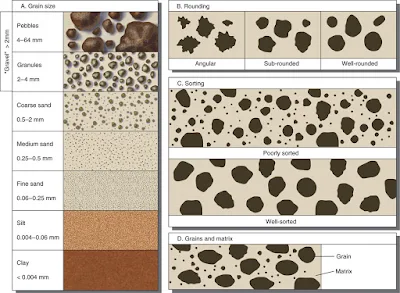Study Reveals How Climate Influences Sediment Size
The size of sediment particles can have a number of impacts on the environment. For example, smaller sediment particles can be more easily transported by water, which can lead to flooding and erosion. Larger sediment particles can settle out of the water more easily, which can help to prevent flooding and erosion. The size of sediment particles can also affect the quality of water, as smaller particles can carry more pollutants.
In a new paper published in the Proceedings of the National Academy of Sciences (PNAS), San Francisco State University Professor of Earth and Climate Sciences Leonard Sklar and colleagues show how two established geochemical techniques can be combined in a novel way to reveal both the altitude where river rocks were originally produced and the rate of erosion that led them to crumble into the river.
Geologists have long dreamed of interviewing the rocks on the bed of a river to learn the story of where they were born and how they came to be the size they are. This is because the size of river rocks influences how rivers behave, from the habitat they provide to the speed with which they carve canyons. Yet, until now, the rocks have withheld their secrets.
Sklar, along with lead author Cliff Riebe and doctoral student Claire Lukens from the University of Wyoming and David Shuster from the University of California, Berkeley, wanted to understand how climate, which varies with altitude, controls the size and flux of sediments in rivers.
The National Science Foundation-funded research team's key breakthrough came when it used two techniques to query river rocks. First, researchers used cosmogenic nuclides to trace erosion rates in sediment samples. This common method of measuring erosion rates uses rare isotopes formed in minerals exposed to cosmic rays at the earth's surface. A higher concentration of isotopes means the rock has spent a longer time exposed at the surface, indicating a slower erosion rate.
They then combined this technique with detrital thermochronometry, another sediment tracing tool, which pinpoints where on a mountain sediment was produced. This is done by laboriously isolating tiny crystals of the mineral apatite and using ultraprecise machines to count the number of helium atoms contained in the crystals. The helium is formed by radioactive decay of uranium and is more abundant in rocks at higher elevations in the study area.
The findings are significant for two reasons, Sklar said. The results show that the size of sediment that falls into rivers is larger where mountain slopes are steeper, colder and less vegetated, revealing how climate and topography influence the size of sediments in rivers. Sediment size, in turn, controls how fast rivers cut canyons into rock, which ultimately limits how high mountains can rise.
"With this new way of interrogating river rocks," Sklar continued, "we can close the circle between how hillslopes feed rocks to the river and how the river carves the landscape and creates the hillslopes in the first place."
This article titled "Climate and topography control the size and flux of sediment produced on steep mountain slopes" was published online Nov. 16. The research was conducted in California's High Sierra Mountains, which tower above Inyo Creek, a small watershed adjacent to Mt. Whitney, the highest peak in the contiguous United States.
The study was published in the journal Proceedings of the National Academy of Sciences
In a new paper published in the Proceedings of the National Academy of Sciences (PNAS), San Francisco State University Professor of Earth and Climate Sciences Leonard Sklar and colleagues show how two established geochemical techniques can be combined in a novel way to reveal both the altitude where river rocks were originally produced and the rate of erosion that led them to crumble into the river.
Geologists have long dreamed of interviewing the rocks on the bed of a river to learn the story of where they were born and how they came to be the size they are. This is because the size of river rocks influences how rivers behave, from the habitat they provide to the speed with which they carve canyons. Yet, until now, the rocks have withheld their secrets.
 |
| grain-size/rounding/sorting chart. |
Sklar, along with lead author Cliff Riebe and doctoral student Claire Lukens from the University of Wyoming and David Shuster from the University of California, Berkeley, wanted to understand how climate, which varies with altitude, controls the size and flux of sediments in rivers.
They then combined this technique with detrital thermochronometry, another sediment tracing tool, which pinpoints where on a mountain sediment was produced. This is done by laboriously isolating tiny crystals of the mineral apatite and using ultraprecise machines to count the number of helium atoms contained in the crystals. The helium is formed by radioactive decay of uranium and is more abundant in rocks at higher elevations in the study area.
The findings are significant for two reasons, Sklar said. The results show that the size of sediment that falls into rivers is larger where mountain slopes are steeper, colder and less vegetated, revealing how climate and topography influence the size of sediments in rivers. Sediment size, in turn, controls how fast rivers cut canyons into rock, which ultimately limits how high mountains can rise.
"With this new way of interrogating river rocks," Sklar continued, "we can close the circle between how hillslopes feed rocks to the river and how the river carves the landscape and creates the hillslopes in the first place."
This article titled "Climate and topography control the size and flux of sediment produced on steep mountain slopes" was published online Nov. 16. The research was conducted in California's High Sierra Mountains, which tower above Inyo Creek, a small watershed adjacent to Mt. Whitney, the highest peak in the contiguous United States.
The study was published in the journal Proceedings of the National Academy of Sciences

%20(1).webp)






